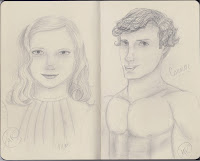 |
| Small shelf of current WIP bibles |
I'm a plotter. I didn't start out that way, but as I continued to write, my critique partners/writing buddies told me I must learn to plot. Yeah. Sure. Right. Me plot?
But their reasoning was that once I sold a book or two, I'd need to be able to write a full synopsis. I thought that if I knew what would happen in the story, it would totally ruin the fun of writing. Those CPs were ruthless, and so I learned to plot. Now I can't write without plotting. ☺
I'm visual. I wish I would have known that in high school. It might have saved a lot of hours...days...weeks. But now that I know it, not to mention that the memory of something I thought of two minutes ago can vanish into thin air, I've become aware that if I don't write it down and keep it somewhere, a thought, an idea, a name, a conversation/dialogue between characters can be gone in a the blink of an eye.
I didn't start out building a bible. I didn't even know there was such a thing. Now I know that a lot of writers make them and use them. Do a search on the internet for *how to build a story bible* and see how many articles are available.
The key to a bible is how you put it together. Sue's won't look like Jane's. Ann's won't look like Sue's. It's an individual "thang" when building a bible. You make and use what you need. Pick and choose what works best for you.
My method is to use a 3" binder. I started using white, but I've found that using a different color for different genres works well, too. If I'd known I'd be writing a 10-book series, I might have chosen a special color for it. I didn't, so all 11 binders are white. (One for each book and a separate for the series.)
 |
| Outside front of bible |
 |
| Heroine & Hero |
Characters are the most important thing in a story, both who they are and what they look like. (Harlequin likes us to send pictures of well-known people for our cover ideas.) There are many places to find pictures for characters. Modeling websites, photo sites (do a web search), even Pinterest are helpful.
 |
| Character List |
Next comes a complete list of character names, starting with the hero and heroine and including the names of any characters that appear in the book or are mentioned by name. After having to hunt for the name of the waitress at the local cafe, who appears randomly throughout the series, or the parents who were mentioned by name, but never appeared, I decided everyone with a name was needed, after all. If a new character appears, the name and who they are (related to hero/heroine or minor character, even if only mentioned), that character goes on the list.
It helps to know the ages of each of the main characters, their children, brothers and sisters, and babies born that are relevant, so I create an age chart for each book (below left). The first year at the top (in the right column of the graph) is the year in which the book takes place, then drops by each year, until the oldest character is born. There's enough room to put a few words for something such as "moved to Desperation" or "Graduated high school," anything that might be a major event in time that appears as backstory in the book. If it's a book within a series, I have a chart with the main characters' ages in all the books. If there are children, those ages are listed, too. (below right)
 |
| Age charts story and Series Main Characters |
 |
| Small storyboard and Calendar of Scenes |
 |
| Full year calendar and Timeline |
 |
| House plan and photo, with aerial shot of the layout of the land |
 |
| Layout of ranch yard and My Working Calendar |
For more information on Story Bibles, check out Taming the Series Beast on my author blog. There are also links there for information on how other writers create their bibles.
So there it is. My method of keeping track. While I'd never dreamed of writing a 10-book series, the first two books grew into more new books, and I'm thankful I'd already begun to keep a bible for each book. To keep all the major series information and a complete list of all characters (even those mentioned) and a complete age chart, who they are and what books they appear in, I use a 1/2" binder.
Remember, if you decide to create a story bible, do it your way. Mine is only one of many.
Are you completely confused? Overwhelmed? That's okay. It's done little by little. For more details, you can give me a shout in the comments. There are always little tricks to make it easier.
Oh, and HAPPY THANKSGIVING!!! (We're having our turkey day tomorrow.)














